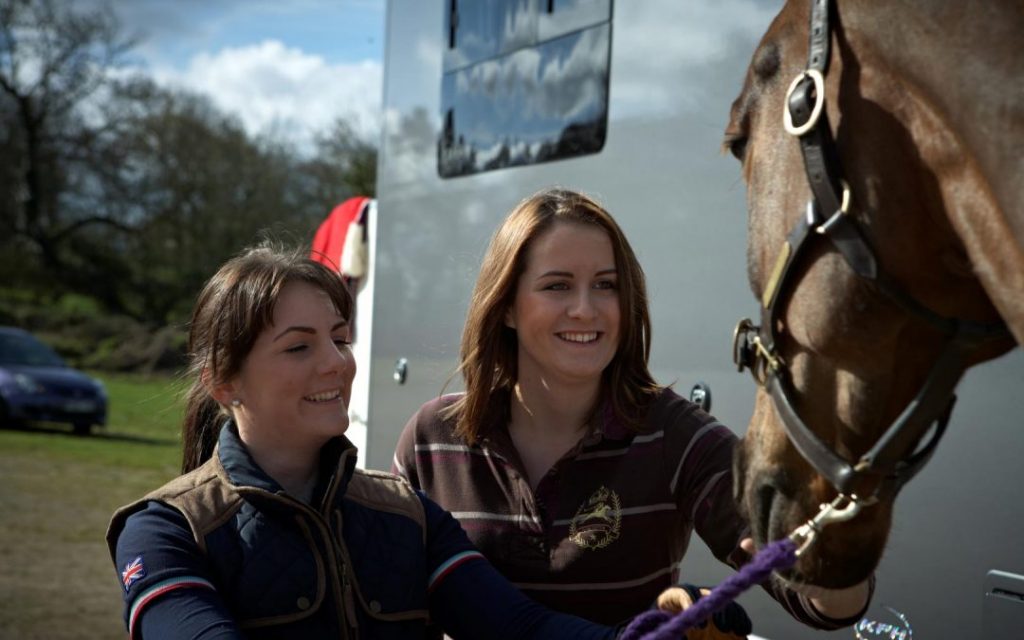Stress free horse loading and transporting
Designing a horse area around horse loading and transporting is most definitely an art. It is something that takes years of experience and there are many factors to take into consideration.
At KPH our horsebox designs are strikingly different and all started with the premise that the horse loading and transporting were to take priority over other considerations. When we wrote everything down that needed incorporating into our horseboxes the actual list was considerable. Putting the list in an order of importance so we could work through it was a task on its own, actually implementing it was something else entirely! Once everything was down on paper it was clear we could not just copy what others were doing and incorporate the safety aspects and improvements we wanted in our designs. After much consideration we decided that for our Aeos and Helios models we would start again and design from the ground up. This was a monumental task, but it allowed us to discard designs and practices that have become outdated. More importantly it allowed us do reduce load heights to add stability, lower our ramp heights and angles and make other safety features integral in our designs.
Safety and loading features for horse loading
As you can imagine we have seen some questionable design issues that would simply put any horse off loading. Some are just clearly dangerous, some are poor design and others are corner cutting and then there are a few that are just overlooked completely. We thought it worth pointing out that a few that are important and certainly worth considering so customers can avoid them or alter them for easier loading.
1. Narrow ramps with large curved rear corners look nice, make the ramp smaller and easier to manufacture but in reality actually make the horse area opening small and dark – ramps and the openings should be as wide as possible for easy loading.
2. High load heights (horse floor height from road) make the ride uncomfortable at best, at worst they can make vehicles unstable. Subframe designs tend to be copied from what has been the norm for decades – As a forward thinking company it was high on our agenda to incorporate the lowest load heights possible.
3. High load heights have other detrimental effects including making ramps too steep – at an absolute maximum DEFRA recommend a 20 degree angle. This is an area where through innovative design our horseboxes clearly stand out.
4. Ramps with extended feet to reduce steep angles have a large step up at ground level and make loading difficult – any ramp design should avoid these legs completely and DEFRA recommend a maximum step of just 100mm.
5. The step up from the top of the ramp into the horse area floor is another problematic area and we have seen steps as high as 250mm. Large steps here actually make the horse jump onto the ramp – again a good design will make this step very small.
6. Horse areas often have small windows at the head end making the horse areas hot with poor air circulation – airflow from large windows at both sides with added roof vents or air extraction should be an integral part of any comfortable horsebox design.
7. Heavy rubber horse mats on the horse floor and kick sheets with capping on the walls are not protection against water, chemical cleaners and urine. They add extra weight and if the horse area is not waterproof even aluminum floors will start to corrode. Over the years we have seen everything from fiberglass to glue and paint used to try to waterproof the horse area and none have lasted. This is an area where we shine. To promote longevity we pioneered Coat-X spray on Polyurea protective coating and we have various finishes for areas throughout our horseboxes. To aid horse loading and transporting we protect our whole horse area and ramp with Coat-X. It is totally waterproof, does not age or crack and it is not affected by heat or cold. More importantly it is light and completely removes the need for seams and cappings.
8. We have seen horse area walls in every colour including stainless steel. Apart from spooking a nervous horse they can often have weight implications. It is worth noting that colour can also have a negative effect on stress levels – our rule is the fewer colours the better and always keeping them around the light end of the spectrum and preferably white.
9. Many of the horseboxes we repair are still manufactured with rivets, bolts and screw and on the road they rattle and vibrate constantly adding to stress for the horses. Our innovative design is far stronger and incorporates the latest adhesives and body tapes reducing noise and vibration by up to 40%. Our Coat-X spray on Polyurea protective coating is also a sound proofing agent and reduces the horse area noise and vibration even further.
Built to last
The whole aim of our design and construction techniques is to further promote quality and the longevity of our horseboxes whilst providing stress free horse loading and transporting. We have easily achieved this and offer customers something quite unique throughout the Helios and Aeos ranges.

